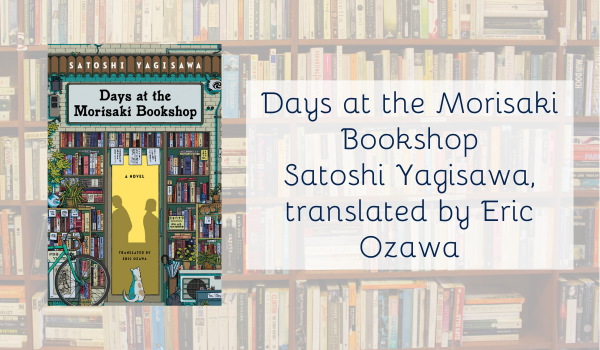Summary
Unable to accept being dumped by her colleague, Takako quits her job and moves into the used bookstore owned by her uncle, Satoru, in Jinbocho. Despite her initial lack of interest in novels, Takako is slowly drawn into the world of books as she comes into contact with the unusual customers who frequent the store.
The Story
This book is like a warm hug on a biting winter day. It’s comforting, it’s cosy, it’s safe. It gives you a place to shelter from the world which, coincidentally, is exactly what the protagonist is doing.
Having been unceremoniously dumped by her boyfriend, Takako leaves her job in the city and moves into her Uncle Satoru’s used book store. Here, she takes time to pause and gather her strength before embarking on the next stage of her life. When she arrives at the book store, Takako finds that her uncle is also dealing with some pretty difficult things. His wife left without saying a word and Satoru is occupied trying to find a way to keep the book store, and himself, going.
The book is split into two parts: the first focuses on Takako and how her uncle helps her find herself again. The second part then focuses on Takako helping her uncle and his wife sort through their issues. The change in dynamic – Satoru first being the caregiver, then Takako transitioning into this role – was interesting and maybe not entirely unexpected. The relationship between niece and uncle was quite endearing. They’ve got each others’ backs, supporting and encouraging one another to face their fears. I really enjoyed this relationship because it felt real, it felt supportive, it felt like family.
Satoru’s general attitude to life is positive, he seems to embrace things with his arms wide open. His laidback approach results in him sharing some pretty profound thoughts throughout the story.
One of my favourites was:
“Even though we think of it as an independent business, what matters in the industry more than anything are the relationships you have with people. I guess that’s probably true of the world in general,” he said, looking rather pleased with himself.
And another:
It’s important to stand still sometimes. Think of it as a little rest in the long journey of your life. This is your harbor. And your boat is just dropping anchor here for a little while. And after you’re well rested, you can set sail again.
The seemingly chaotic uncle is actually a philosophical genius. I loved that he threw in these random profound thoughts, usually while doing something a little ridiculous. This complements Takako’s more practical and straightforward approach to things. The juxtaposition of these two characters’ personalities was a highlight of the book for me.
The Language
Satoshi Yagisawa and Eric Ozawa have created an absolute masterpiece in the English translation. Yagisawa’s creative use of language is evocative and relatable, Ozawa has, in turn, paid the same care and attention to getting the meaning across in English. I adore the descriptions of people and places throughout the book. They’re creative, unique, and amusing – the author and translator have gone for a subtle approach to humour which I really enjoy.
Takako, at one point, describes her uncle as “as flexible and indecisive as a jellyfish.” In just a few simple words, I had an almost complete picture of Satoru in my head from the instant we met him. As the story went on, Yagisawa’s descriptions confirmed that Takako’s initial assessment of Satoru was correct.
I liked the way the author, and translator, used language to paint a picture for the reader. One particular example shows how you can use words to create two very different contrasting images:
The place had a very lived-in look. To put it nicely, I guess you could call it unpretentious. To put it not so nicely, it was a dump.
Two words (”unpretentious” and “dump”) create two very different images in the reader’s mind, echoing a situation that feels very realistic. Haven’t we all been somewhere and had almost the exact same thought?
Final Thoughts
I can completely understand why this story has had such a positive welcome into the international market – it’s easy to read and is relatable. I connected with the story when Takako devours her first book in the used book store. She spends the entire night reading, then seems to catch the reading bug and can’t put her books down.
And yet for all I read, I found book after book that I still wanted to read.
Yagisawa has captured a very particular feeling that bookworms around the world can connect with: Finally finding the book that “gets” you, a book that you read and it instantly becomes part of you, it nestles into your heart and soul, and stays with you forever.
For me, Days at the Morisaki Bookshop is one of those books. The feeling of warmth and cosiness I got while reading will stick with me for a while.
A big thanks to the author, Satoshi Yagisawa, the English translator, Eric Ozawa, and Kelly Doyle at HarperCollins Publishers for providing me with a copy of Days at the Morisaki Bookshop.
Bookshop.org | Amazon | Goodreads

- Book Review: Welcome to the Hyunam-Dong Bookshop by Hwang Bo-Reum - May 21, 2025
- Book Review: Pentimento Mori: An Art History Mystery - March 13, 2025
- Book Review: We Need No Wings - September 23, 2024
